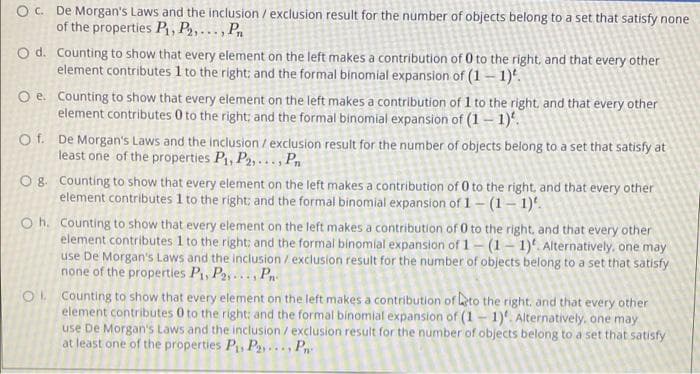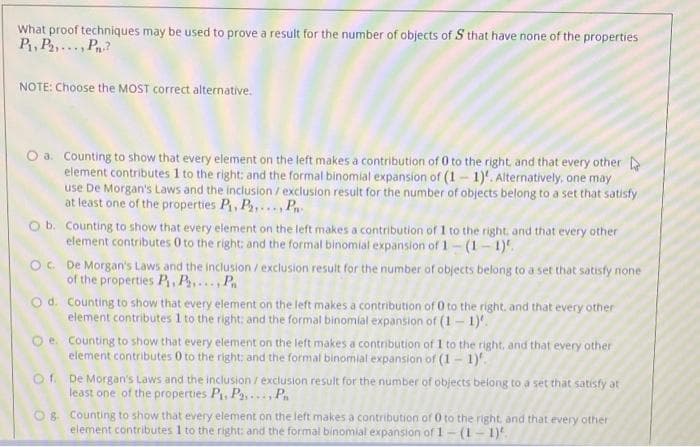What proof techniques may be used to prove a result for the number of objects of S that have none of the properties P, P,.P? NOTE: Choose the MOST correct alternative. O a. Counting to show that every element on the left makes a contribution of 0 to the right, and that every other element contributes 1 to the right: and the formal binomial expansion of (1- 1)'. Alternatively, one may use De Morgan's Laws and the inclusion / exclusion result for the number of objects belong to a set that satisfy at least one of the properties P, P,., P Ob. Counting to show that every element on the left makes a contribution of 1 to the right, and that every other element contributes 0 to the right: and the formal binomial expansion of 1- (1 – 1). Oc De Morgan's Laws and the inclusion / exclusion result for the number of objects belong to a set that satisfy none of the properties P, P P Od. Counting to show that every element on the left makes a contribution of 0 to the right, and that every other element contributes 1 to the right: and the formal binomial expansion of (1- 1)'. Oe Counting to show that every element on the left makes a contribution of 1 to the right, and that every other element contributes 0 to the right: and the formal binomial expansion of (1- 1) Of. De Morgan's Laws and the inclusion / exclusion result for the number of objects belong to a set that satisfy at least one of the properties P, P3,..., P O8 Counting to show that every element on the left makes a contribution of 0 to the right, and that every other element contributes 1 to the right: and the formal binomial expansion of1-(1-1)
What proof techniques may be used to prove a result for the number of objects of S that have none of the properties P, P,.P? NOTE: Choose the MOST correct alternative. O a. Counting to show that every element on the left makes a contribution of 0 to the right, and that every other element contributes 1 to the right: and the formal binomial expansion of (1- 1)'. Alternatively, one may use De Morgan's Laws and the inclusion / exclusion result for the number of objects belong to a set that satisfy at least one of the properties P, P,., P Ob. Counting to show that every element on the left makes a contribution of 1 to the right, and that every other element contributes 0 to the right: and the formal binomial expansion of 1- (1 – 1). Oc De Morgan's Laws and the inclusion / exclusion result for the number of objects belong to a set that satisfy none of the properties P, P P Od. Counting to show that every element on the left makes a contribution of 0 to the right, and that every other element contributes 1 to the right: and the formal binomial expansion of (1- 1)'. Oe Counting to show that every element on the left makes a contribution of 1 to the right, and that every other element contributes 0 to the right: and the formal binomial expansion of (1- 1) Of. De Morgan's Laws and the inclusion / exclusion result for the number of objects belong to a set that satisfy at least one of the properties P, P3,..., P O8 Counting to show that every element on the left makes a contribution of 0 to the right, and that every other element contributes 1 to the right: and the formal binomial expansion of1-(1-1)
Elements Of Modern Algebra
8th Edition
ISBN:9781285463230
Author:Gilbert, Linda, Jimmie
Publisher:Gilbert, Linda, Jimmie
Chapter2: The Integers
Section2.2: Mathematical Induction
Problem 40E: Exercise can be generalized as follows: If and the set has elements, then the number of elements...
Related questions
Question
5

Transcribed Image Text:O. De Morgan's Laws and the inclusion / exclusion result for the number of objects belong to a set that satisfy none
of the properties P1 , P2,.., Pn
O d. Counting to show that every element on the left makes a contribution of 0 to the right, and that every other
element contributes 1 to the right; and the formal binomial expansion of (1 – 1)'.
O e. Counting to show that every element on the left makes a contribution of 1 to the right, and that every other
element contributes 0 to the right: and the formal binomial expansion of (1 – 1)".
Of. De Morgan's Laws and the inclusion / exclusion result for the number of objects belong to a set that satisfy at
least one of the properties P1, P2, ..., Pn
O8 Counting to show that every element on the left makes a contribution of 0 to the right, and that every other
element contributes 1 to the right; and the formal binomial expansion of 1 – (1 – 1)'.
O h. Counting to show that every element on the left makes a contribution of 0 to the right, and that every other
element contributes 1 to the right: and the formal binomial expansion of 1- (1 – 1)'. Alternatively, one may
use De Morgan's Laws and the inclusion / exclusion result for the number of objects belong to a set that satisfy
none of the properties P, P2,. P
OL Counting to show that every element on the left makes a contribution of Ato the right, and that every other
element contributes 0 to the right: and the formal binomial expansion of (1- 1)'. Alternatively, one may
use De Morgan's Laws and the inclusion / exclusion result for the number of objects belong to a set that satisfy
at least one of the properties P, P2 P

Transcribed Image Text:What proof techniques may be used to prove a result for the number of objects of S that have none of the properties
P, P,..., P
NOTE: Choose the MOST correct alternative.
O a. Counting to show that every element on the left makes a contribution of 0 to the right, and that every other
element contributes 1 to the right: and the formal binomial expansion of (1- 1)'. Alternatively, one may
use De Morgan's Laws and the inclusion /exclusion result for the number of objects belong to a set that satisfy
at least one of the properties P, P,.. , P
O b. Counting to show that every element on the left makes a contribution of 1 to the right, and that every other
element contributes 0 to the right: and the formal binomial expansion of 1(1- 1).
O. De Morgan's Laws and the inclusion / exclusion result for the number of objects belong to a set that satisfy none
of the properties P, P P
O d. Counting to show that every element on the left makes a contribution of 0 to the right, and that every other
element contributes 1 to the right: and the formal binomial expansion of (1- 1).
Oe. Counting to show that every element on the left makes a contribution of 1 to the right, and that every other
element contributes 0 to the right: and the formal binomial expansion of (1 - 1)'.
of De Morgan's Laws and the inclusion / exclusion result for the number of objects belong to a set that satisty at
least one of the properties P, Pa,... P.
O8 Counting to show that every element on the left makes a contribution of 0 to the right, and that every other
element contributes 1 to the right: and the formal binomial expansion of 1- (1- 1)
Expert Solution
This question has been solved!
Explore an expertly crafted, step-by-step solution for a thorough understanding of key concepts.
Step by step
Solved in 5 steps

Recommended textbooks for you

Elements Of Modern Algebra
Algebra
ISBN:
9781285463230
Author:
Gilbert, Linda, Jimmie
Publisher:
Cengage Learning,

Algebra & Trigonometry with Analytic Geometry
Algebra
ISBN:
9781133382119
Author:
Swokowski
Publisher:
Cengage

College Algebra
Algebra
ISBN:
9781305115545
Author:
James Stewart, Lothar Redlin, Saleem Watson
Publisher:
Cengage Learning

Elements Of Modern Algebra
Algebra
ISBN:
9781285463230
Author:
Gilbert, Linda, Jimmie
Publisher:
Cengage Learning,

Algebra & Trigonometry with Analytic Geometry
Algebra
ISBN:
9781133382119
Author:
Swokowski
Publisher:
Cengage

College Algebra
Algebra
ISBN:
9781305115545
Author:
James Stewart, Lothar Redlin, Saleem Watson
Publisher:
Cengage Learning

Algebra and Trigonometry (MindTap Course List)
Algebra
ISBN:
9781305071742
Author:
James Stewart, Lothar Redlin, Saleem Watson
Publisher:
Cengage Learning

Linear Algebra: A Modern Introduction
Algebra
ISBN:
9781285463247
Author:
David Poole
Publisher:
Cengage Learning
